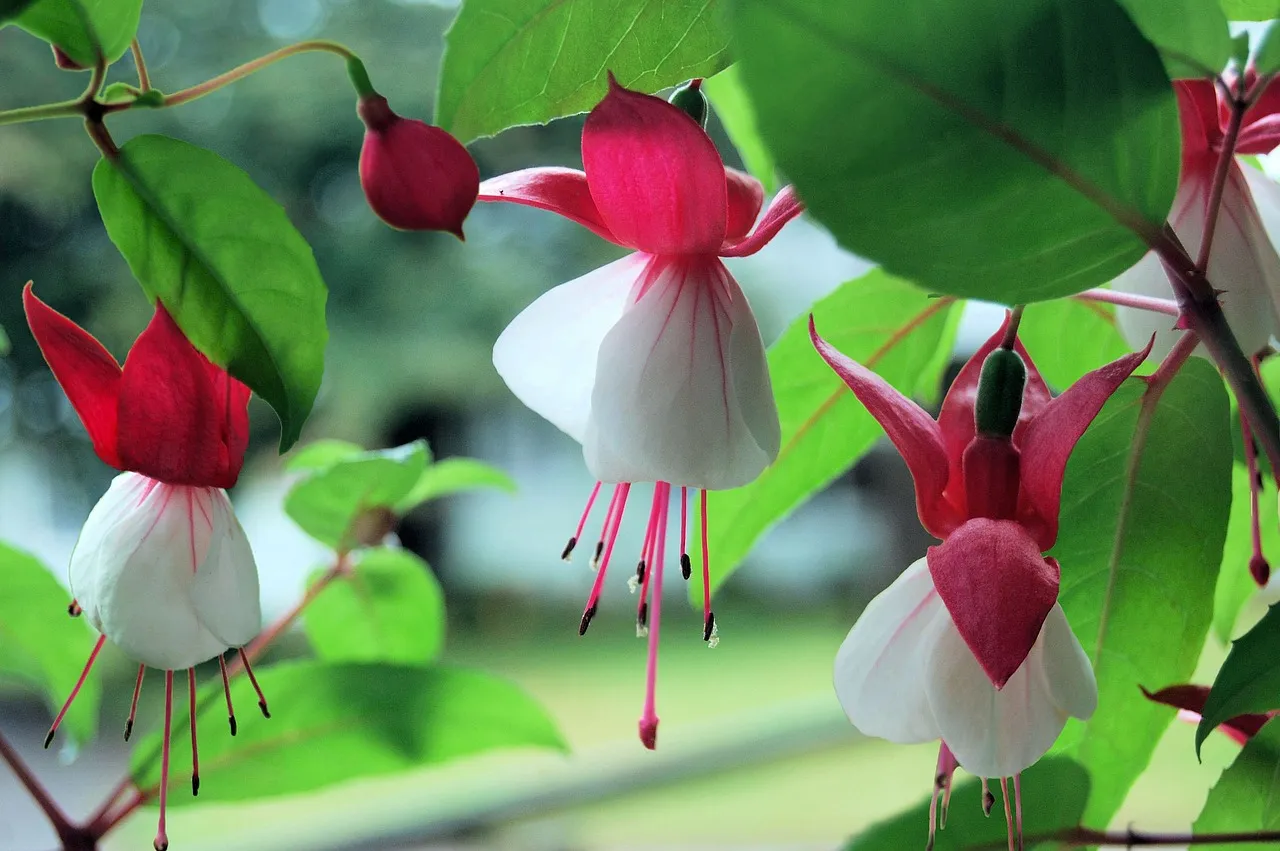Welcome to our blog post, “Fuchsia Flowers 101: Essential Care Tips for Your Balcony Garden.” If you’re a gardening enthusiast looking to add a touch of vibrant beauty to your balcony, fuchsia flowers are an excellent choice. With their striking colors and graceful blooms, fuchsias can transform any outdoor space into a captivating oasis.
However, to ensure these delightful plants thrive and flourish in your balcony garden, proper care and attention are essential. In this comprehensive guide, we’ll walk you through the fundamental care tips and best practices for cultivating healthy and flourishing fuchsia flowers in the limited space of your balcony. Let’s dive in and unlock the secrets to nurturing these charming botanical wonders!

Choosing the Perfect Fuchsia Varieties: A Guide for Balcony Gardeners
When it comes to fuchsia flowers, the first step to creating a stunning balcony garden is selecting the right varieties. With a plethora of options available, it can be overwhelming to decide which ones will thrive in your unique space. To make this process easier, consider factors such as sunlight exposure, climate, and available space.
Opt for hardy fuchsia varieties that can withstand different weather conditions. Some popular choices for balcony gardens include “Tom Thumb,” “Swingtime,” and “Dollar Princess.” By understanding the specific requirements of each variety, you can ensure a successful and flourishing fuchsia display that will mesmerize you and your visitors throughout the growing season.
Types of Fuchsia Plants:
Fuchsia hybrid cultivars:
Fuchsia hybrid cultivars are the result of crossbreeding different fuchsia species, creating a wide array of unique and captivating varieties. These hybrids often display a blend of colors and characteristics inherited from their parent plants. Some popular hybrid cultivars include “Delta’s Sarah,” known for its striking red and purple flowers, and “Gartenmeister Bonstedt,” famous for its vibrant orange-red blooms.
These hybrids offer balcony gardeners a diverse range of fuchsia options, each with its distinct charm and growing requirements. When caring for hybrid cultivars, it is essential to consider the specific needs of each variety, from sunlight exposure to pruning techniques, to ensure they flourish and grace your balcony with their enchanting presence.
Fuchsia magellanica varieties:
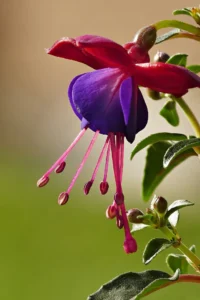
Fuchsia magellanica is a species native to South America and is known for its hardiness and resilience. The varieties within this species often feature delicate, pendulous flowers in hues of pink, purple, and white. “Riccartonii,” with its deep red and purple blooms, and “Alba,” with its pure white flowers, are popular choices among fuchsia magellanica enthusiasts.
These varieties are well-suited for balcony gardens, as they can tolerate cooler temperatures and are relatively low-maintenance. Providing them with well-draining soil, regular watering, and partial shade will help them thrive, adding a touch of natural beauty to your outdoor sanctuary.
Fuchsia boliviana species:
Fuchsia boliviana, also known as “Bolivian fuchsia,” is a species native to the Andes region and is renowned for its impressive size and showy flowers. Unlike other fuchsia species, fuchsia boliviana can grow as a shrub or small tree, reaching heights of up to 15 feet. Its pendant flowers are typically vivid red or orange-red and attract various pollinators, making it an excellent choice for wildlife-friendly balcony gardens. “Alba,” a white-flowering variety of fuchsia boliviana, is equally captivating.
As these plants can grow significantly larger than other fuchsia species, they require ample space and regular pruning to maintain their shape and size. With proper care and space considerations, fuchsia boliviana species can become a stunning focal point in your balcony garden, impressing visitors with their impressive stature and striking blooms.
Fuchsia triphylla cultivars:
Fuchsia triphylla, also known as “Firecracker fuchsia,” is a species characterized by its elegant and slender leaves and small, tubular flowers. The cultivars within this species often feature vibrant hues of red, pink, and purple, attracting hummingbirds and butterflies to your balcony garden. “Gartenmeister Bonstedt,” with its coral-orange flowers, and “Firecracker,” with its striking red blooms, are popular choices among fuchsia triphylla enthusiasts.
These cultivars thrive in warmer climates and prefer partial shade, making them ideal choices for balconies with limited direct sunlight. Regular deadheading and pruning will encourage continuous blooming and maintain the plant’s compact and bushy form. Incorporating fuchsia triphylla cultivars into your balcony garden will infuse it with a burst of color and attract delightful winged visitors to your outdoor oasis.
Fuchsia splendens variations:
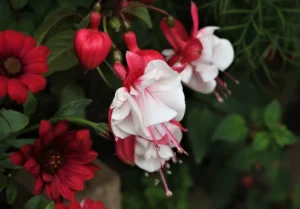
Fuchsia splendens, also known as “Scarlet fuchsia,” is a species native to Mexico and Central America, celebrated for its bright scarlet flowers. The variations within this species offer a range of shades from vivid reds to deep purples. “Coccinea,” with its intense scarlet blooms, and “Speciosa,” known for its rich purple flowers, are popular choices among fuchsia splendens enthusiasts. These variations thrive in warm, tropical climates and require regular watering and well-draining soil to prevent waterlogging.
As fuchsia splendens can be sensitive to cold temperatures, they may require protection or overwintering in colder regions. Incorporating these stunning variations into your balcony garden will undoubtedly create a bold and eye-catching floral display, evoking the vibrancy and charm of their native regions. With proper care and attention, fuchsia splendens variations will bloom abundantly, filling your balcony with their fiery beauty and enchanting allure.
Understanding Fuchsia Flower Colors: Picking the Right Shades for Your Balcony
The mesmerizing allure of fuchsia flowers lies not only in their elegant form but also in the dazzling array of colors they exhibit. From vibrant pinks and purples to delicate whites and reds, each hue adds a unique touch to your balcony garden. Understanding the significance of fuchsia flower colors can help you curate a harmonious and eye-catching floral display.
For a vibrant and striking look, consider combining contrasting shades like deep purple and bright pink. If you prefer a more soothing and elegant ambiance, opt for a monochromatic color scheme with varying intensities of the same color. By strategically selecting fuchsia flower colors, you can create an enchanting and visually appealing outdoor oasis right on your balcony.
The Best Containers for Fuchsia: Balancing Aesthetics and Functionality
Choosing the right containers is vital to ensure the health and growth of your fuchsia plants. Balcony gardeners must strike a balance between aesthetics and functionality when selecting containers for fuchsia flowers. Consider containers that allow proper drainage to prevent waterlogged soil, which can lead to root rot. Hanging baskets and window boxes are popular choices for their space-saving design and visual appeal.
Terracotta pots, though traditional, may dry out quickly in warm climates, requiring more frequent watering. Alternatively, plastic or resin containers retain moisture better. Whichever type you choose, ensure they are large enough to accommodate the root system and provide sufficient space for your fuchsia plants to flourish and showcase their full splendor.
Fuchsia Planting Techniques: Getting Started with Transplants and Seeds
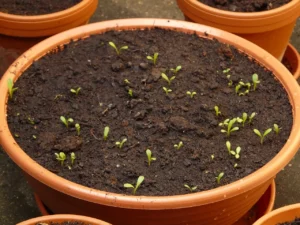
Once you’ve chosen your preferred fuchsia varieties and containers, it’s time to get your hands in the soil and start planting. Fuchsia plants can be grown from transplants or seeds, and each method has its unique benefits. Transplants are readily available at nurseries, saving you time and effort. However, growing from seeds can be a rewarding experience, allowing you to witness the entire life cycle of the plant.
For successful transplanting, ensure the root ball is intact during the transfer and water thoroughly to reduce transplant shock. When sowing seeds, use a well-draining potting mix and provide consistent moisture until germination occurs. Whichever planting technique you choose, the thrill of nurturing fuchsia flowers from their early stages to full bloom will undoubtedly be a gratifying journey.
Balcony Microclimates: Finding the Ideal Spot for Your Fuchsia Flowers
The microclimate on your balcony can significantly influence the growth and health of your fuchsia flowers. Understanding the unique conditions and microclimates within your balcony space is crucial to placing your fuchsias in their ideal spot. Observe how sunlight patterns change throughout the day, noting areas with direct sunlight and those that remain shaded. Fuchsias generally prefer filtered sunlight to protect their delicate blooms from scorching heat.
Take note of any potential wind tunnels or exposed corners, as strong winds can damage the fragile branches. Additionally, consider the proximity to other structures or plants that may cast shadows and affect light distribution. By identifying and utilizing these microclimates effectively, you can create microhabitats that cater to the specific needs of your fuchsia flowers, ensuring their optimal growth and well-being.
Watering Wisdom: How to Maintain the Right Moisture Balance for Fuchsias
Watering fuchsia flowers requires a delicate balance, as they’re sensitive to both underwatering and overwatering. Frequent watering is necessary, especially in warmer months, but avoid waterlogging to prevent root rot. Test soil moisture regularly and adjust watering accordingly. In high heat, mist leaves for humidity. Self-watering systems or moisture meters can help maintain consistent moisture levels for healthy, vibrant fuchsia flowers.
Fuchsia Fertilization Demystified: Nourishing Your Blooms for Maximum Growth

To promote lush foliage and abundant blooms, fuchsia plants require proper nourishment. Fertilizing your fuchsias is a crucial aspect of their care routine. Opt for a balanced, water-soluble fertilizer with equal proportions of nitrogen, phosphorus, and potassium, indicated as N-P-K on the label. Begin fertilizing in the early spring when new growth starts, and continue monthly during the growing season.
Overfertilization can lead to excessive vegetative growth at the expense of flowers, so follow the recommended dosage guidelines. Applying a slow-release fertilizer can provide a steady supply of nutrients to your fuchsia plants over an extended period. With a well-timed and appropriate fertilization regimen, you can help your fuchsia flowers flourish and achieve their full potential in terms of growth and bloom production.
Pruning and Pinching Tips: Shaping Fuchsia Plants for Abundant Flowers
Pruning and pinching are essential techniques to maintain the shape and vigor of your fuchsia plants while encouraging a profusion of blooms. Regularly pruning your fuchsias helps remove dead or diseased growth, improving air circulation and reducing the risk of pests and diseases. Additionally, pinching back the tips of young shoots encourages branching, resulting in a bushier plant with more flower-bearing stems.
Prune lightly during the growing season to maintain the desired shape, and more extensively during late winter or early spring to rejuvenate the plant before the new growth begins. With these pruning and pinching tips, you can sculpt your fuchsia plants into a symphony of lush foliage and vibrant blooms, making your balcony garden a delightful sight to behold.
Dealing with Common Pests and Diseases: Protecting Your Fuchsia Beauties
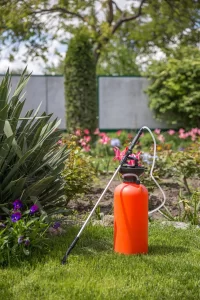
Fuchsia plants, like any other, are susceptible to pests and diseases that can compromise their health and beauty. Recognizing the signs of common issues and promptly taking action is crucial to preserving the well-being of your fuchsia flowers. Keep a vigilant eye out for pests such as aphids, whiteflies, and spider mites, which can quickly infest your plants and cause damage. Natural remedies like neem oil or insecticidal soap can help control minor infestations, while pruning heavily infested areas may be necessary for severe cases.
Fungal diseases like botrytis and rust can also affect fuchsia plants, especially in humid conditions. Proper spacing and adequate air circulation can minimize the risk of fungal infections. Should your fuchsia flowers fall victim to pests or diseases, swift intervention can save them from irreversible damage, ensuring their continuous bloom and vitality.
Overwintering Fuchsia on Your Balcony: Preparing for the Colder Months
As colder months approach, preparing fuchsia plants for winter becomes crucial, especially for balcony gardeners. Overwintering fuchsia requires care, as they are less sheltered than garden fuchsias. Before the first frost, prune and bring them indoors to a cool, well-lit spot like a sunroom or ventilated garage.
Maintain above-freezing temperatures and water sparingly during their semi-dormant state. Address pests or diseases promptly. In spring, reintroduce fuchsias gradually to the outdoors, where they’ll awaken and fill your balcony with renewed beauty and color.
Fuchsia Companion Plants: Enhancing the Beauty and Health of Your Garden
Companion planting is a smart technique to maximize the beauty and health of your fuchsia garden. Choosing the right companions can provide added aesthetic appeal, deter pests, and improve pollination. Flowers like begonias and lobelia complement fuchsias beautifully with their vibrant colors and similar care requirements. Marigolds and petunias act as natural pest repellents, keeping harmful insects away from your delicate fuchsia blooms.
Including herbs like basil and mint can also contribute to the health of your balcony garden while adding a touch of fragrance. However, be mindful of the individual needs and growth habits of each plant, ensuring they are compatible companions for your fuchsias. With a well-chosen combination of companion plants, you can create a harmonious and thriving garden space that showcases the splendor of your fuchsia flowers.
Fuchsia in Hanging Baskets: Creating Breathtaking Cascades of Color

Hanging baskets offer a stunning and space-saving way to display fuchsia flowers, transforming your balcony into a mesmerizing cascade of colors and foliage. The key to successful fuchsia hanging baskets lies in proper planting and maintenance. Start with a high-quality potting mix that retains moisture without becoming waterlogged. Carefully plant your fuchsia in the center of the basket, surrounded by complementary trailing plants like ivy or trailing lobelia.
Regularly deadhead spent flowers to encourage continuous blooming, and ensure the basket remains well-watered without excess. As fuchsias prefer partial shade, consider hanging your baskets in spots where they receive filtered sunlight for a few hours each day. With their trailing stems cascading gracefully, these fuchsia hanging baskets will undoubtedly add a touch of enchantment to your balcony garden.
Propagation Made Simple: Multiply Your Fuchsia Collection with Ease
Propagating fuchsia plants is an exciting and budget-friendly way to expand your collection or share the joy with others. You can propagate fuchsia through stem cuttings, layering, or division. Stem cuttings are the easiest method: choose healthy stems, remove lower leaves, and place them in a well-draining medium. With care and humidity, the cuttings will develop roots and become new plants.
For layering, bend a low branch to the soil surface to encourage rooting, then separate it from the parent once rooted. Division is less common but can be done during repotting with multiple stems. Mastering these methods will create a thriving fuchsia garden with captivating varieties.
Tips for Fuchsia Flower Arrangements: Bringing Indoor Elegance to Your Home
While fuchsias are renowned for their outdoor beauty, they can also bring elegance and charm to your indoor spaces. Fuchsia flower arrangements make a delightful addition to your home decor, infusing any room with a sense of vibrancy and grace. For stunning floral displays, consider selecting long-stemmed fuchsia blooms paired with complementary greenery and foliage.
Use vases or containers that allow the fuchsia flowers to take center stage while providing support for their delicate stems. To extend the lifespan of your cut fuchsia blooms, change the water regularly and keep the arrangement away from direct sunlight and drafts. Whether adorning your dining table, mantle, or sideboard, these indoor fuchsia arrangements will add a touch of nature’s beauty to your interior spaces.
Troubleshooting Fuchsia Issues: Solutions to Common Growing Challenges
Even the most experienced gardeners may encounter challenges while caring for their fuchsia flowers. Identifying and addressing these issues promptly can make all the difference in the health and well-being of your plants. For instance, if you notice yellowing leaves, it may be a sign of overwatering or nutrient deficiencies. Adjust your watering schedule and consider fertilizing with a balanced fertilizer.
Wilting and drooping leaves could be due to underwatering, indicating the need for more frequent watering. Brown spots or mold may indicate fungal diseases, requiring prompt intervention to prevent further spread. By staying observant and proactive, you can troubleshoot these common fuchsia growing challenges effectively, ensuring your balcony garden remains a lush and thriving sanctuary of natural beauty.
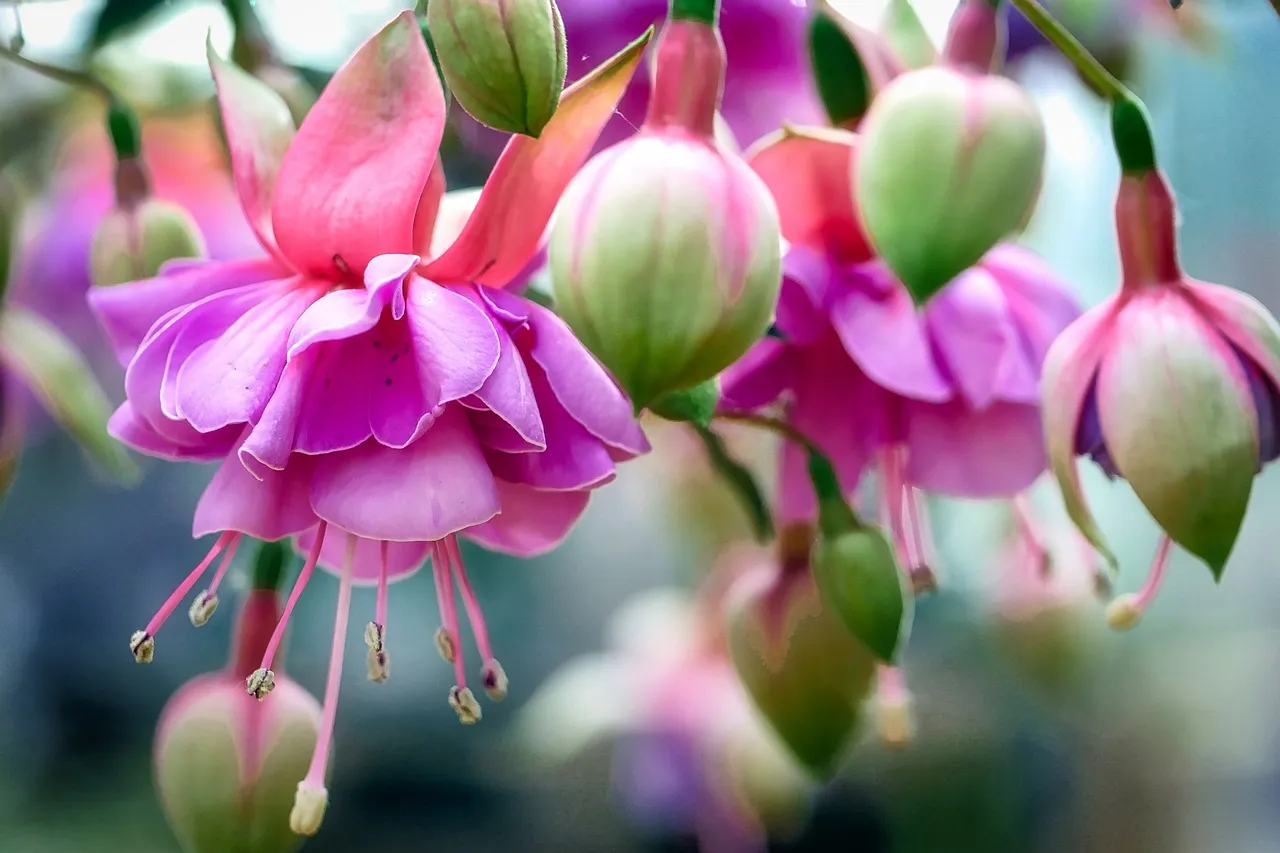
Most Frequently Asked Questions on Fuchsia:
Are fuchsia flowers suitable for balcony gardening?
Absolutely! Fuchsia flowers are well-suited for balcony gardening, especially if you have limited space. These elegant and colorful blooms thrive in containers and hanging baskets, making them perfect for adorning your balcony with their beauty. Just ensure they receive enough filtered sunlight and water regularly to keep them healthy and vibrant.
How much sunlight do fuchsia flowers need?
Fuchsia flowers prefer partial shade, as direct sunlight can scorch their delicate blooms. Place them in spots where they receive morning sunlight or dappled shade throughout the day. In hot climates, protect them from the intense midday sun to prevent wilting and stress on the plants.
What type of soil is best for fuchsia plants?
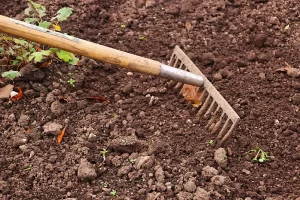
Fuchsia plants prefer well-draining soil to prevent waterlogged roots. Use a high-quality potting mix that retains moisture without becoming soggy. Adding organic matter can improve the soil’s structure and fertility, creating an optimal growing environment for your fuchsias.
How often should I water my fuchsia flowers?
How often you water fuchsia depends on weather, container size, and humidity. Generally, water when the top inch of soil is dry. Avoid overwatering to prevent root rot and other problems.
How should I fertilize my fuchsia plants?
Fertilize your fuchsia plants with a balanced, water-soluble fertilizer with equal proportions of nitrogen, phosphorus, and potassium. Begin fertilizing in the early spring when new growth starts and continue monthly during the growing season. Be cautious not to overfertilize, as it may lead to excessive vegetative growth at the expense of flowers.
Do fuchsia flowers attract pollinators?
Yes, fuchsia flowers are excellent attractors of pollinators, such as hummingbirds and butterflies. The tubular shape of their blooms and their vibrant colors make them irresistible to these winged visitors. By cultivating fuchsias on your balcony, you can create a pollinator-friendly oasis that brings joy and life to your garden.
How do I prune my fuchsia plants for abundant blooms?
Pruning is essential for shaping fuchsia plants and encouraging prolific flowering. Regularly remove dead or diseased growth to improve air circulation and prevent pests and diseases. Pinch back the tips of young shoots to encourage branching, leading to a bushier plant with more flower-bearing stems.
Can I propagate my fuchsia plants?
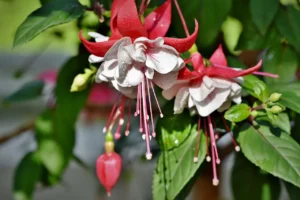
Indeed! Fuchsia plants can be propagated through stem cuttings, layering, and division. Stem cuttings are the simplest and most popular method. Choose healthy, non-flowering stems and place them in a well-draining rooting medium. With proper care, the cuttings will develop roots and grow into new plants.
How do I protect my fuchsia plants from pests and diseases?
To maintain healthy fuchsia plants and ward off pests, be vigilant. Check for aphids, whiteflies, and spider mites regularly. For minor infestations, use natural remedies like neem oil or insecticidal soap. Proper spacing and air circulation can prevent fungal diseases.
Can I bring my fuchsia plants indoors during the winter?
Yes, fuchsia plants can be overwintered indoors if you live in a colder climate. Before the first frost, prune your fuchsias to reduce their size and bring them indoors to a cool, well-lit location. Ensure the temperature remains above freezing and water sparingly during their semi-dormant period. In spring, gradually reintroduce them outdoors.
How do I choose the right fuchsia varieties for my balcony garden?
Selecting the perfect fuchsia varieties for your balcony garden involves considering factors such as sunlight exposure, climate, and available space. Opt for hardy fuchsia varieties that can withstand different weather conditions. Popular choices include “Tom Thumb,” “Swingtime,” and “Dollar Princess.” Understanding the specific requirements of each variety will ensure a successful and flourishing fuchsia display.
What are the best companion plants for fuchsia flowers?
Companion planting is an excellent technique to enhance the beauty and health of your balcony garden. Flowers like begonias and lobelia complement fuchsias with their vibrant colors and similar care requirements. Marigolds and petunias act as natural pest repellents. Including herbs like basil and mint can also improve the health of your garden.
Can I grow fuchsia flowers from seeds?
Yes, fuchsia plants can be grown from seeds, but it requires patience and proper care. Use a well-draining potting mix and sow the seeds on the surface, lightly covering them with a thin layer of soil. Keep the soil consistently moist, and provide warmth and indirect light for germination to occur.
How do I create stunning fuchsia hanging baskets?
Fuchsia hanging baskets bring a stunning color cascade to your balcony. Choose a good potting mix that holds moisture but avoids waterlogging. Position your fuchsia in the center and complement it with trailing plants such as ivy or trailing lobelia. Keep up with deadheading to ensure continuous blooms.
Are fuchsia flowers annual or perennial?
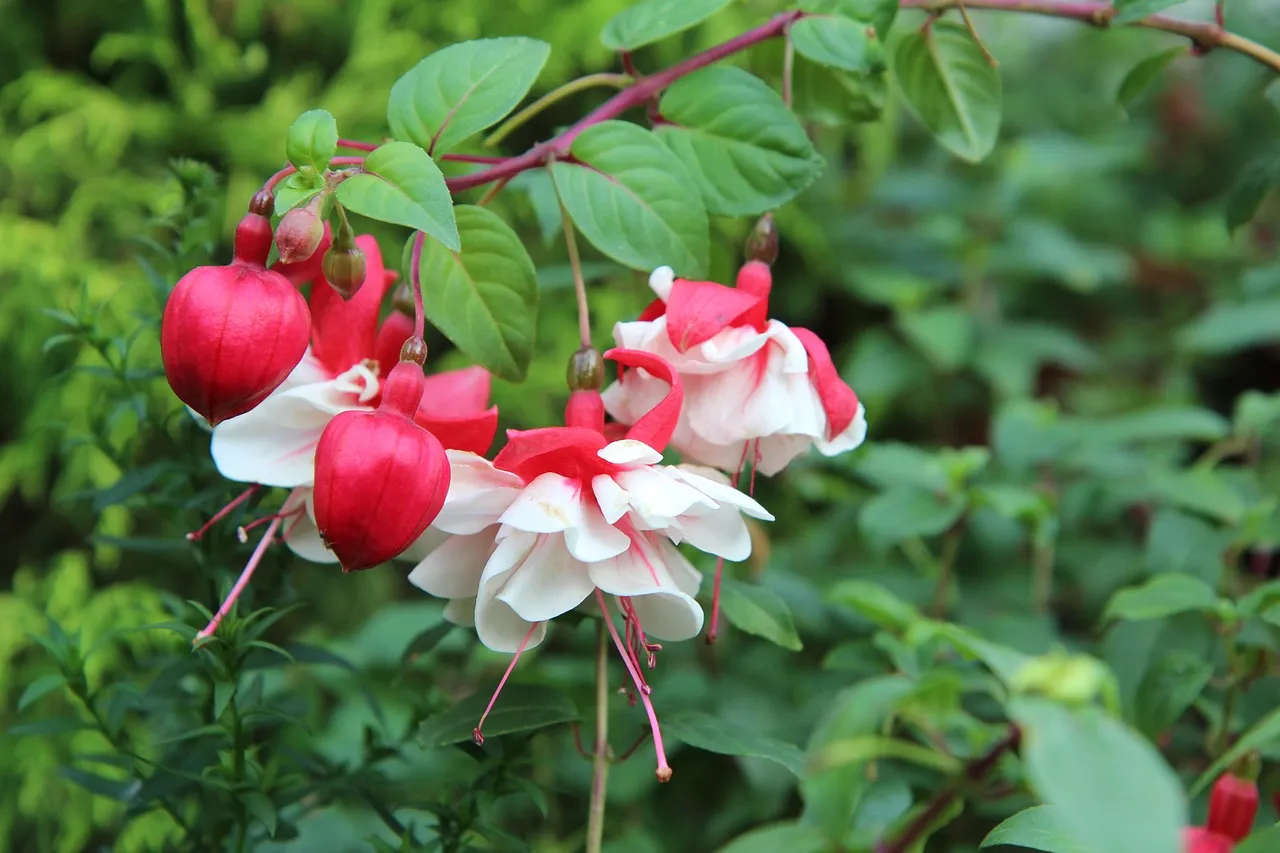
The answer depends on the variety. Some fuchsia species are perennial, meaning they can survive and bloom year after year, while others are annual and complete their life cycle in a single growing season. Check the specific variety’s characteristics to determine if it is an annual or perennial type for your balcony garden.
